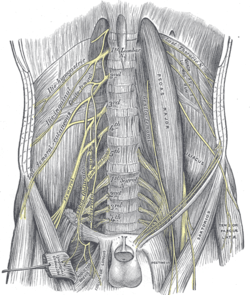Genitofemoral nerve
| Genitofemoral nerve | |
|---|---|
 Plan of lumbar plexus. (Genitofemoral nerve visible at upper left.) | |
 The lumbar plexus and its branches. (Genitofemoral nerve visible at upper left.) | |
| Details | |
| From | lumbar plexus |
| To | lumboinguinal, genital branch |
| Innervates | cremaster |
| Identifiers | |
| Latin |
Nervus genitofemoralis Nervus genitalifemoralis |
| TA | A14.2.07.008 |
| FMA | 16484 |
The genitofemoral nerve refers to a human nerve that is found in the abdomen. Its branches, the genital branch and femoral branch supply sensation to the upper anterior thigh, as well as the skin of the anterior scrotum in males and mons pubis in females. The femoral branch is different from the femoral nerve, which also arises from the lumbar plexus.
Anatomy
The genitofemoral nerve originates from the upper L1-2 segments of the lumbar plexus. It passes downwards, pierces psoas major and emerges from its anterior surface . The nerve divides into two branches, the genital branch and the lumboinguinal nerve also known as the femoral branch,[1] both of which then continue downwards and medially to the inguinal and femoral canal respectively.
Genital Branch
The genital branch passes through the deep inguinal ring and enters the inguinal canal. In men, the genital branch supplies the cremaster and scrotal skin. In women, the genital branch accompanies the round ligament of uterus, terminating in and innervating the skin of the mons pubis and labia majora.[1]
Femoral Branch
The femoral branch passes underneath the inguinal ligament, travelling through the lateral muscular compartment of the femoral canal where it communicates with the femoral nerve. Passing through the cribriform fascia of the saphenous opening of the fascia lata of the thigh, it then supplies the skin of the upper, anterior thigh.[1]
Function
The genitofemoral nerve is responsible for both the sensory (femoral branch) and motor portions (genital branch) of the cremasteric reflex, which describes contraction of the cremasteric muscle when the skin of the superior medial part of the thigh is touched.[1] :262
Additional images
-

Deep and superficial dissection of the lumbar plexus.
-
Genitofemoral nerve
-
Genitofemoral nerve
See also
External links
- Anatomy photo:36:07-0305 at the SUNY Downstate Medical Center - "Inguinal Region, Scrotum and Testes: Layers of the spermatic cord"
- Anatomy figure: 40:07-13 at Human Anatomy Online, SUNY Downstate Medical Center - "Muscles and nerves of the posterior abdominal wall."
- posteriorabdomen at The Anatomy Lesson by Wesley Norman (Georgetown University) (posteriorabdmus&nerves)